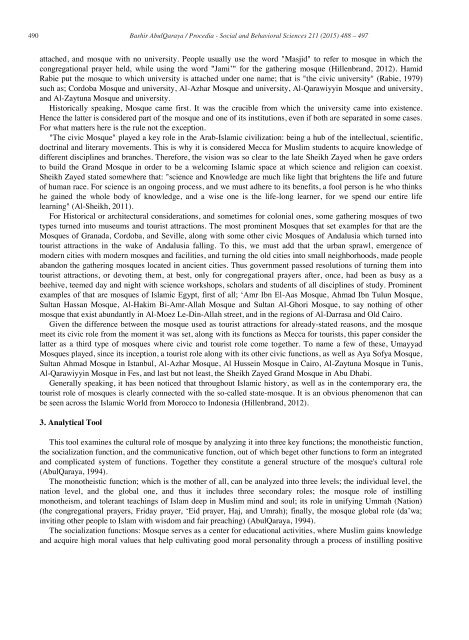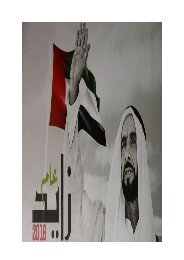1-s2.0-S1877042815054051-main
You also want an ePaper? Increase the reach of your titles
YUMPU automatically turns print PDFs into web optimized ePapers that Google loves.
490 Bashir AbulQaraya / Procedia - Social and Behavioral Sciences 211 ( 2015 ) 488 – 497<br />
attached, and mosque with no university. People usually use the word "Masjid" to refer to mosque in which the<br />
congregational prayer held, while using the word "Jami’" for the gathering mosque (Hillenbrand, 2012). Hamid<br />
Rabie put the mosque to which university is attached under one name; that is "the civic university" (Rabie, 1979)<br />
such as; Cordoba Mosque and university, Al-Azhar Mosque and university, Al-Qarawiyyin Mosque and university,<br />
and Al-Zaytuna Mosque and university.<br />
Historically speaking, Mosque came first. It was the crucible from which the university came into existence.<br />
Hence the latter is considered part of the mosque and one of its institutions, even if both are separated in some cases.<br />
For what matters here is the rule not the exception.<br />
"The civic Mosque" played a key role in the Arab-Islamic civilization: being a hub of the intellectual, scientific,<br />
doctrinal and literary movements. This is why it is considered Mecca for Muslim students to acquire knowledge of<br />
different disciplines and branches. Therefore, the vision was so clear to the late Sheikh Zayed when he gave orders<br />
to build the Grand Mosque in order to be a welcoming Islamic space at which science and religion can coexist.<br />
Sheikh Zayed stated somewhere that: "science and Knowledge are much like light that brightens the life and future<br />
of human race. For science is an ongoing process, and we must adhere to its benefits, a fool person is he who thinks<br />
he gained the whole body of knowledge, and a wise one is the life-long learner, for we spend our entire life<br />
learning" (Al-Sheikh, 2011).<br />
For Historical or architectural considerations, and sometimes for colonial ones, some gathering mosques of two<br />
types turned into museums and tourist attractions. The most prominent Mosques that set examples for that are the<br />
Mosques of Granada, Cordoba, and Seville, along with some other civic Mosques of Andalusia which turned into<br />
tourist attractions in the wake of Andalusia falling. To this, we must add that the urban sprawl, emergence of<br />
modern cities with modern mosques and facilities, and turning the old cities into small neighborhoods, made people<br />
abandon the gathering mosques located in ancient cities. Thus government passed resolutions of turning them into<br />
tourist attractions, or devoting them, at best, only for congregational prayers after, once, had been as busy as a<br />
beehive, teemed day and night with science workshops, scholars and students of all disciplines of study. Prominent<br />
examples of that are mosques of Islamic Egypt, first of all; ‘Amr Ibn El-Aas Mosque, Ahmad Ibn Tulun Mosque,<br />
Sultan Hassan Mosque, Al-Hakim Bi-Amr-Allah Mosque and Sultan Al-Ghori Mosque, to say nothing of other<br />
mosque that exist abundantly in Al-Moez Le-Din-Allah street, and in the regions of Al-Darrasa and Old Cairo.<br />
Given the difference between the mosque used as tourist attractions for already-stated reasons, and the mosque<br />
meet its civic role from the moment it was set, along with its functions as Mecca for tourists, this paper consider the<br />
latter as a third type of mosques where civic and tourist role come together. To name a few of these, Umayyad<br />
Mosques played, since its inception, a tourist role along with its other civic functions, as well as Aya Sofya Mosque,<br />
Sultan Ahmad Mosque in Istanbul, Al-Azhar Mosque, Al Hussein Mosque in Cairo, Al-Zaytuna Mosque in Tunis,<br />
Al-Qarawiyyin Mosque in Fes, and last but not least, the Sheikh Zayed Grand Mosque in Abu Dhabi.<br />
Generally speaking, it has been noticed that throughout Islamic history, as well as in the contemporary era, the<br />
tourist role of mosques is clearly connected with the so-called state-mosque. It is an obvious phenomenon that can<br />
be seen across the Islamic World from Morocco to Indonesia (Hillenbrand, 2012).<br />
3. Analytical Tool<br />
This tool examines the cultural role of mosque by analyzing it into three key functions; the monotheistic function,<br />
the socialization function, and the communicative function, out of which beget other functions to form an integrated<br />
and complicated system of functions. Together they constitute a general structure of the mosque's cultural role<br />
(AbulQaraya, 1994).<br />
The monotheistic function; which is the mother of all, can be analyzed into three levels; the individual level, the<br />
nation level, and the global one, and thus it includes three secondary roles; the mosque role of instilling<br />
monotheism, and tolerant teachings of Islam deep in Muslim mind and soul; its role in unifying Ummah (Nation)<br />
(the congregational prayers, Friday prayer, ‘Eid prayer, Haj, and Umrah); finally, the mosque global role (da’wa;<br />
inviting other people to Islam with wisdom and fair preaching) (AbulQaraya, 1994).<br />
The socialization functions: Mosque serves as a center for educational activities, where Muslim gains knowledge<br />
and acquire high moral values that help cultivating good moral personality through a process of instilling positive




